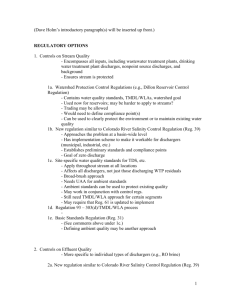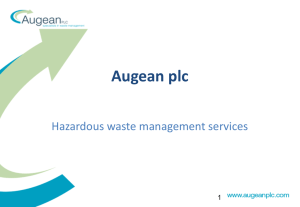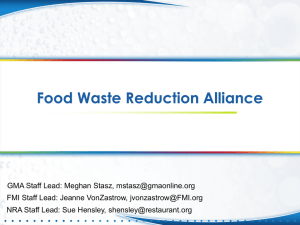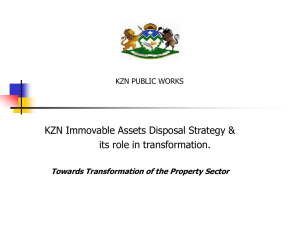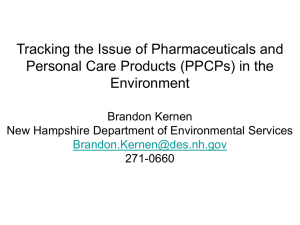Membrane Treatment - Regulatory Options for Membrane Treatment
advertisement
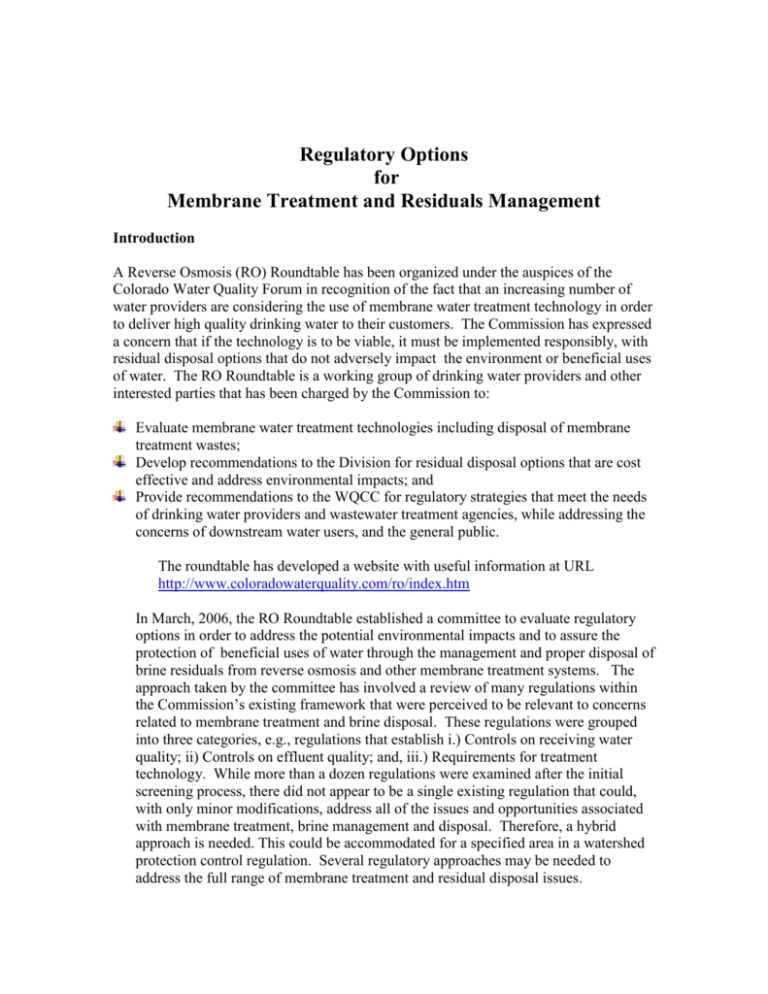
Regulatory Options for Membrane Treatment and Residuals Management Introduction A Reverse Osmosis (RO) Roundtable has been organized under the auspices of the Colorado Water Quality Forum in recognition of the fact that an increasing number of water providers are considering the use of membrane water treatment technology in order to deliver high quality drinking water to their customers. The Commission has expressed a concern that if the technology is to be viable, it must be implemented responsibly, with residual disposal options that do not adversely impact the environment or beneficial uses of water. The RO Roundtable is a working group of drinking water providers and other interested parties that has been charged by the Commission to: Evaluate membrane water treatment technologies including disposal of membrane treatment wastes; Develop recommendations to the Division for residual disposal options that are cost effective and address environmental impacts; and Provide recommendations to the WQCC for regulatory strategies that meet the needs of drinking water providers and wastewater treatment agencies, while addressing the concerns of downstream water users, and the general public. The roundtable has developed a website with useful information at URL http://www.coloradowaterquality.com/ro/index.htm In March, 2006, the RO Roundtable established a committee to evaluate regulatory options in order to address the potential environmental impacts and to assure the protection of beneficial uses of water through the management and proper disposal of brine residuals from reverse osmosis and other membrane treatment systems. The approach taken by the committee has involved a review of many regulations within the Commission’s existing framework that were perceived to be relevant to concerns related to membrane treatment and brine disposal. These regulations were grouped into three categories, e.g., regulations that establish i.) Controls on receiving water quality; ii) Controls on effluent quality; and, iii.) Requirements for treatment technology. While more than a dozen regulations were examined after the initial screening process, there did not appear to be a single existing regulation that could, with only minor modifications, address all of the issues and opportunities associated with membrane treatment, brine management and disposal. Therefore, a hybrid approach is needed. This could be accommodated for a specified area in a watershed protection control regulation. Several regulatory approaches may be needed to address the full range of membrane treatment and residual disposal issues. Each of the regulations that were evaluated has certain elements that might be incorporated into a set of requirements to address membrane treatment and residuals management. These have been identified below in the discussion of regulatory options. There does appear to be a need for some underlying control on receiving water quality to serve as the basis for any proposed control on effluent quality or treatment technology. While a generalized technology-based approach of establishing minimum effluent limitations or treatment requirements could establish a ‘floor’ for performance expectations related to brine management and disposal, it likely would not always assure site-specific protection of the environment and existing beneficial uses of water. There is not an existing 304(a) criterion, nor a primary maximum contaminant level (MCL) for total dissolved solids or salinity. While there is a secondary MCL for salinity [500 mg/l], it is not enforceable, at least, in surface water bodies. It would be an enormous, costly and technically daunting undertaking to embark upon a process of establishing a water quality criterion or drinking water standard for TDS in state waters (or drinking water). Moreover, such an approach potentially could result in the creation of an indiscriminant regulatory burden for all dischargers (or water providers). The regulatory committee was charged with identifying options more closely targeted to preventing adverse impacts of membrane treatment-related residuals. Therefore, there is some interest in developing a template for a watershed protection control regulation because it could be established by the Commission at any desired watershed scale and be tailored to address specific water quality concerns. It would be possible to establish a narrative or numerical protection level in the context of a watershed protection control regulation that would have only site-specific and industry-specific applicability. The effective protection level could be based upon existing ambient quality, aquatic life uses, agricultural or drinking water uses. It would also be possible, albeit somewhat complicated, to specify effluent limitations, waste load allocations and/or treatment requirements in a control regulation focused on a specific water body. Such a control regulation could provide a framework for pollutant trading, as well. There was a consensus among the committee members that different regulatory options may be appropriate depending on the number and scale of specific facilities relying upon membrane treatment in a watershed. This may lend further support to the concept of water body-specific control regulations where there are multiple potential brine sources and indicate a need for discharger-specific regulatory solutions in isolated cases. A number of different regulatory options may accommodate small individual sources of brine wastewater, including those governing indirect discharges to POTWs. The RO Roundtable has established a separate committee to examine various technical approaches for the management and disposal of brine concentrates. It is expected that the work products from that committee will provide substantive information for the regulatory options committee to consider when technology-based requirements are evaluated. There is recognition that individual water utilities may be able to manage brine wastes only to a certain degree and there may also be a need for regional approaches for enhanced brine dewatering and ultimate disposal of residual solids. A generic technical assessment is needed to accurately reflect the potential water quality impacts at a community-wide level, which are associated with membrane treatment and residuals disposal, as opposed to conventional treatment, or where large numbers of point-of-use RO devices are used in combination with conventional treatment. Various scenarios for brine discharges should be evaluated, as well, e.g., direct discharge of brine concentrates, discharge in accordance with flow-based limits, discharge to alluvial ground water, deep aquifer injection and disposal of residual solids in a regional monofill. Where appropriate, the evaluation should focus on real time changes in water quality associated with discharges, as opposed to generalized loading comparisons under different scenarios. Such an assessment is needed to provide the technical underpinnings for any new regulatory development efforts in this arena. REGULATORY OPTIONS 1. Controls on Stream Quality - Encompasses all inputs, including wastewater treatment plants, drinking water treatment plant discharges, non-point source discharges, and background - Ensures stream is protected 1a. Watershed Protection Control Regulations (e.g., Dillon Reservoir Control Regulation) - Contains water quality standards, TMDL/WLAs, watershed goal - Used now for reservoirs; may be harder to apply to streams? - Trading may be allowed - Would need to define compliance point(s) - Can be used to clearly protect the environment or to maintain existing water quality 1b. New regulation similar to Colorado River Salinity Control Regulation (Reg. 39) - Approaches the problem at a basin-wide level - Has implementation scheme to make it workable for dischargers (municipal, industrial, etc.) - Establishes preliminary standards and compliance points - Goal of zero discharge 1c. Site-specific water quality standards for TDS, etc. - Apply throughout stream at all locations - Affects all dischargers, not just those discharging WTP residuals - Broad-brush approach - Needs UAA for ambient standards - Ambient standards can be used to protect existing quality - May work in conjunction with control regs. - Still need TMDL/WLA approach for certain segments - May require that Reg. 61 is updated to implement 1d. Regulation 93 – 303(d)/TMDL/WLA process 1e. Basic Standards Regulation (Reg. 31) - (See comments above under 1c.) - Defining ambient quality may be another approach 2. Controls on Effluent Quality - More specific to individual types of dischargers (e.g., RO brine) 2a. New regulation similar to Colorado River Salinity Control Regulation (Reg. 39) - (See comments above under 1b.) 2b. Effluent Limitations Regulation ((Reg. 62) - Blending may be O.K. if pollutant not specifically regulated under Reg. 62 2c. Watershed Protection Control Regulations (e.g., Dillon Reservoir Control Regulation) - (See comments above under 1a.) 2d. Permit Regulations (Reg. 61) - Will look to either effluent-limits or WQS - ACALF: further evaluation is needed, especially as an option for certain locations, etc. - Could possibly pair ACALF with site-specific control regulation 2e. EPA’s UIC Regulations - Which class applies? (Class I, II, or V) - Potential geologic issues for some locations (can’t qualify under regs) - May also need State Groundwater discharge permit, in addition to UIC permit 2f. Pollutant Trading Program - Pollutant-dependent (Is the pollutant amenable to trading?) - Framework (Pollutant Trading Policy) already in place - Is flexible for non-304(a)-based criteria - May be able to apply TDS criteria at point of DW intake and have some flexibility with where apply MCL-based water quality standards; will need to apply aquatic life standards throughout segment 2g. Pretreatment Regulations (local limits; sewer use ordinance) - To control/limit what may be discharged to sewers/WWTPs - Scale issues (may work for smaller WWTPs) - Site-specific solution for certain facilities - Dependent on receiving stream water quality standards (in part) for calculation of local limits - Essentially can become a prohibition on this disposal option (to sewer/WWTP) for some individual entities, but doesn’t solve overall problem 2h. Effluent Limitation guidelines - EPA is currently examining the promulgation of ELGs for drinking water residuals - Would establish BATs applicable to all - Look at what environmental effects from specific industrial discharge would be (more discharge-specific) 3. Regulatory Requirements on Treatment Technology - Treatment technologies could include: desalination; concentrating solar collectors; cogeneration with nearby power plant facilities; regional disposal or treatment facility 3a. Site Approval-Type Process (similar to Reg. 22) - Gets WQCD sign-off on whatever solution is - Helps avoid (AMY-ADD YOUR “BACKED IN THE CORNER” WORDS HERE) for smaller facilities - May need to develop size cut-off (to which this applies) - Requires a look at all treatment/disposal options early in the process - Watershed-type approach 3b. Design Criteria for Potable Water Systems - Are existing criteria in place; being reworked now - Will add stronger requirements re: facility needs to have viable residual disposal option before WTP is approved 3c. Drinking Water Regulations for Treatment Techniques 3d. Pretreatment Regulations (local limits; sewer use ordinance) - (See comments above under 2g.) 3e. New Consolidation of Facilities Policy (for disposal of brine or solid waste) - Similar to existing Consolidation of WWTPs Policy; would require analysis to see if economies of scale, etc., exist 4. No Need for Any Requirements (“I’m only putting back what I’m taking out”) - Augmentation return flow requirements do require water to be put back - Timing of return flows - Basin-wide calculations - Individual household water softeners vs. treatment at a central facility ( and discharge to sewer vs. discharge from central facility to either sewer or stream) 1. Controls on Stream Quality Watershed Protection Control Regulations Regulation No. 39 – Colorado River Salinity Standards Site-specific Water Quality Standards for TDS, etc. Regulation No. 93 – 303(d)/TMDL/WLA Process 2. Controls on Effluent Quality TNORM/Regional Monofill Regulation No. 39 – Colorado River Salinity Standards Regulation No. 62 – Effluent Limitations Watershed Protection Control Regulations Regulation No. 61 – Permit Regulations EPA’s UIC Regulations Pollutant Trading Program 3. Requirements on Treatment Technology Desalination Site Approval-Type Process (similar to Regulation No. 22) Design Criteria for Potable Water Systems Drinking Water Regulations for Treatment Techniques Pretreatment Regulations (to control discharges to sewers)
